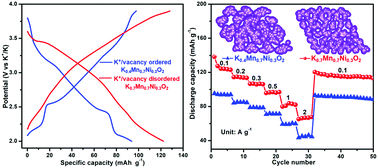K+ modulated K+/vacancy disordered layered oxide for high-rate and high-capacity potassium-ion batteries†
Abstract
With high theoretical capacity and applicable operating voltage, layered transition metal oxides are potential cathodes for potassium-ion batteries (PIBs). However, a K+/vacancy ordered structure in these oxides limits the K+ transport kinetics and storage sites so that the PIBs still have poor rate performance and low achievable capacity. Here, to effectively resolve the problem, a K+/vacancy disordered P3-type structure is designed and synthesized by simply modulating the K+ contents in Mn/Ni-based layered oxides. The effect of the K+ contents in a series of KxMn0.7Ni0.3O2 (x = 0.4–0.7) oxides has been systematically studied and it is found that while the K+/vacancy ordered superstructure is stable at low K+ content (x < 0.6), a complete K+/vacancy disordered structure forms at high K+ content (x > 0.6), evidenced by selected area electron diffraction and voltage plateaus in the charge/discharge curves. The K+/vacancy disordered K0.7Mn0.7Ni0.3O2 exhibits much better rate performance and higher discharge capacity, compared to the K+/vacancy ordered K0.4Mn0.7Ni0.3O2. Molecular dynamic simulations confirm that the K+/vacancy disordered structure possesses interconnected continuous channels for K+ diffusion and more active storage sites. This discovery sheds light on rational design of K+/vacancy disordered layered oxide cathodes for next-generation high-performance PIBs.



 Please wait while we load your content...
Please wait while we load your content...